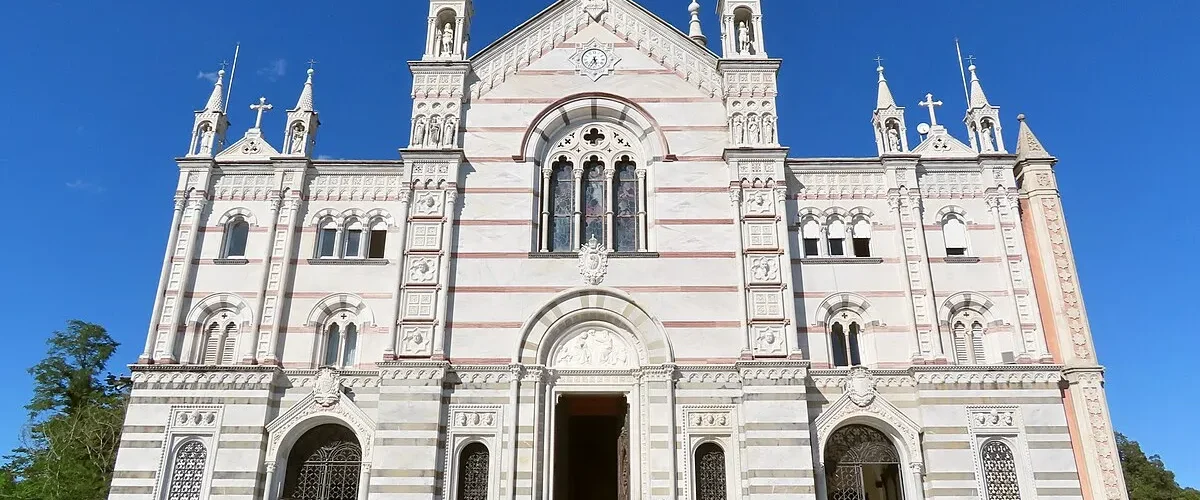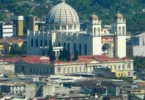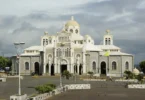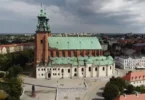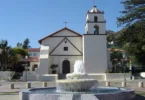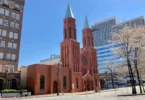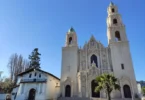Introduction
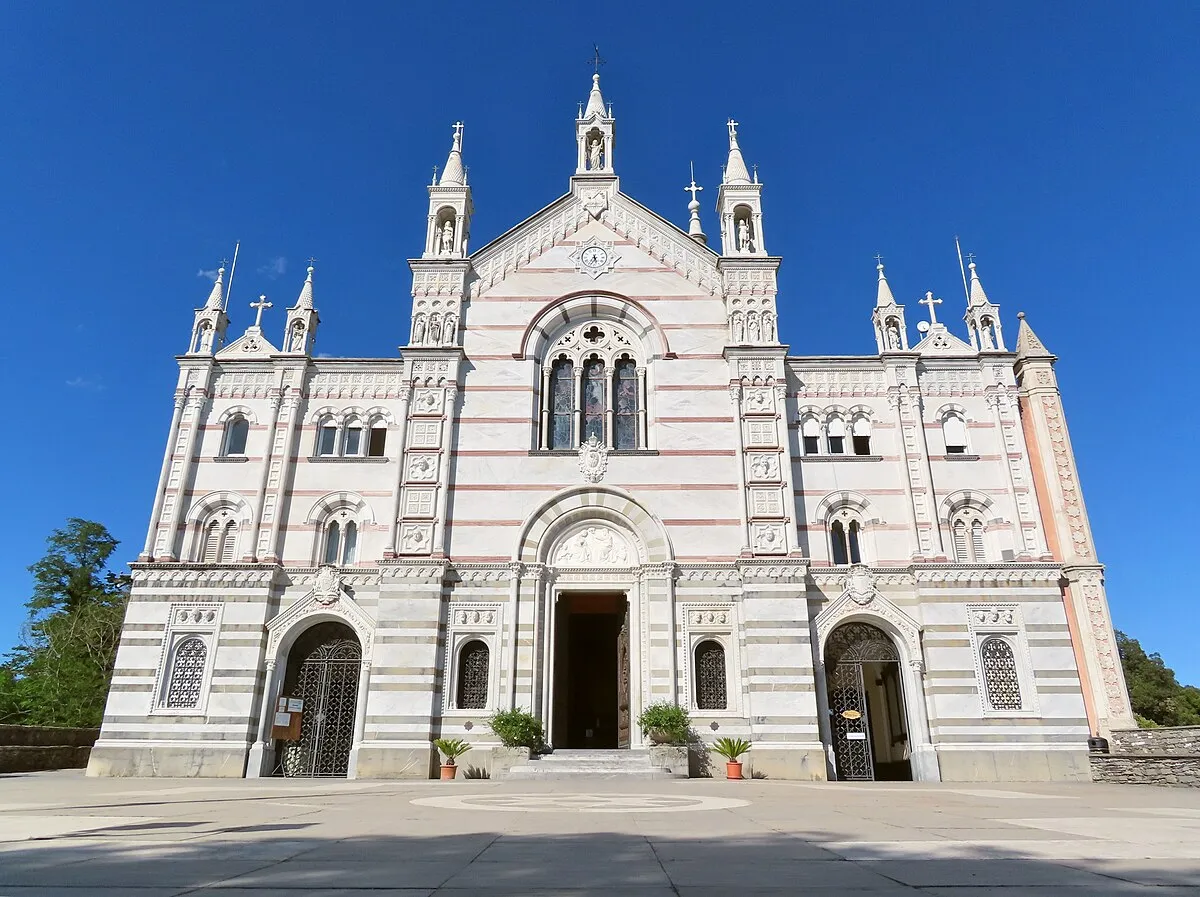
The Basilica Sanctuary of Our Lady of Montallegro is a Catholic place of worship situated in the hamlet of Montallegro, within the municipality of Rapallo, in the metropolitan city of Genoa. The sanctuary is positioned on a hill, standing approximately 612 meters above sea level.
Regarded as one of the most important Marian shrines in the Genoa metropolitan area and Liguria, the basilica was constructed by the people of Rapallo between 1557 and 1558. The building was erected alongside a pilgrims’ shelter after the Virgin Mary appeared to Giovanni Chichizola, a local peasant, on July 2, 1557, according to tradition. The current marble façade was the result of restoration efforts by Milanese architect Luigi Rovelli, completed in 1896 and officially inaugurated on June 21 of the same year.
Since 1739, Our Lady of Montallegro has been the patron saint of Rapallo, a title she was granted that year for the community, its captaincy, and the parishes of Santa Margherita Ligure. This honor is reflected on the municipal coat of arms, which, since November 28, 1948, has featured the Marian monogram—two intertwined letters M and A—placed between two griffins supporting a royal crown.
In addition to her role as the patron saint of Rapallo, Our Lady of Montallegro is also the co-patroness of the Diocese of Chiavari. This designation was officially confirmed by Pope Leo XIII through a papal bull issued on December 3, 1892. Furthermore, the religious hymn Splende in alto, written and composed by Giovanni Battista Campodonico, continues to honor Our Lady of Montallegro, contributing to the ongoing devotion to her.
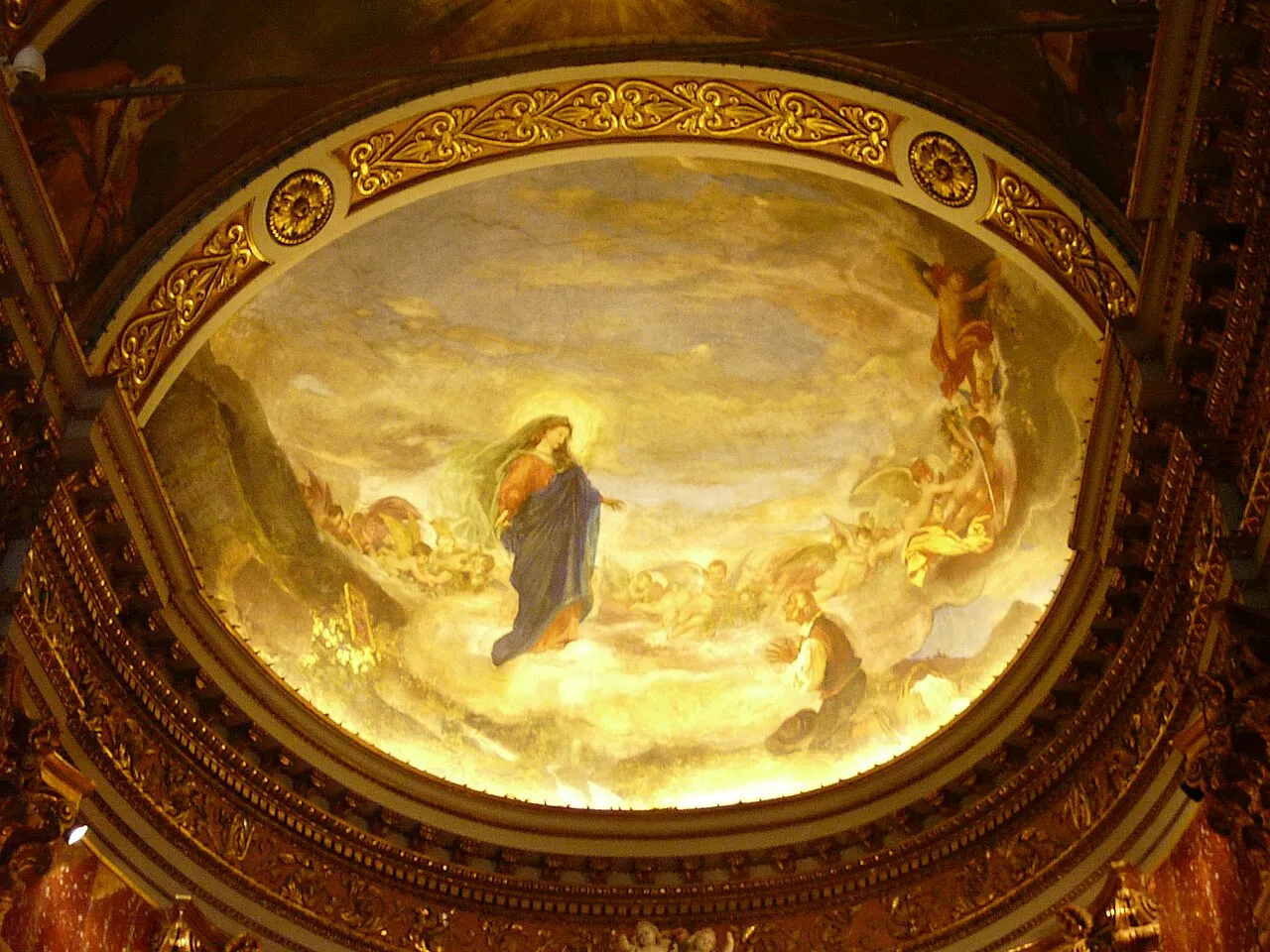
The Marian Apparition
According to local tradition, the Virgin Mary appeared on the afternoon of July 2, 1557, to Giovanni Chichizola, a farmer from San Giacomo di Canevale, a hamlet of Coreglia Ligure. He was returning from the Genoa market and had reached the wooded area of the Ghibelline Della Torre family, near Mount Letho (locally known as the “mount of death” due to frequent brigand raids). Exhausted from his long walk and the heat, Giovanni rested near a rocky outcrop and fell asleep.
Suddenly, he was awakened by a radiant light, and before him stood a woman “dressed in blue and white, looking graceful and kind,” as Giovanni later described to local authorities. She spoke only a few words: “Go and tell the people of Rapallo that I want to be honored here.” As proof of the apparition, the Virgin left a small Byzantine painting depicting the Dormitio Mariae, which Giovanni was to present to the people of Rapallo. Shortly after the apparition, a fresh spring of water began flowing from the very rock where it occurred.
After recovering from the extraordinary event, Giovanni set out to Rapallo to share the Virgin’s message. At first, the townspeople were skeptical, dismissing him as a dreamer or fanatic, due to the ongoing Guelph-Ghibelline conflicts. Feeling discouraged, Giovanni appealed to the local parish priest, who, after confirming the story with the civil authorities, led a group to the site. They found the Byzantine image and the spring, and the priest took the icon to the Basilica of Saints Gervasius and Protasius for safekeeping. However, the next morning, the painting was found back on Mount Letho. This miraculous event confirmed the apparition, and the Virgin’s image was soon venerated by the people of Rapallo.
The Construction of the Sanctuary
The growing devotion to Our Lady of Montallegro prompted the construction of a church to accommodate the increasing number of pilgrims. A small temple was built between 1557 and 1558 to house the Byzantine icon, and a hospice for pilgrims was also established. By 1559, under the guidance of Comacine master Tommasino Lagomaggiore, the sanctuary’s first architectural version, featuring a single nave, was completed.
In 1572, Pope Gregory XIII unified the suppressed monastery of Valle Christi with the sanctuary, and in 1589, the Archdiocese of Genoa officially entrusted the parish of Saints Gervasius and Protasius with managing the sanctuary. Over the centuries, the sanctuary underwent significant expansions and renovations. In 1640, the church was enlarged, and by the 18th century, the guesthouse was also expanded.
The 19th century saw further artistic enhancements, including frescoes by Francesco Boero and Nicolò Barabino. In 1882, Milanese architect Luigi Rovelli redesigned the high altar and facade, incorporating a new Gothic style. A bell tower was completed in 1907, and a wider staircase was constructed in 1982.
In the 20th century, significant infrastructural works included a road to the sanctuary, allowing vehicles to access it, and the addition of new stained-glass windows, Stations of the Cross, and bronze doors. A rack-and-pinion elevator was installed in 2009 to improve accessibility.
The Patronage of Our Lady of Montallegro
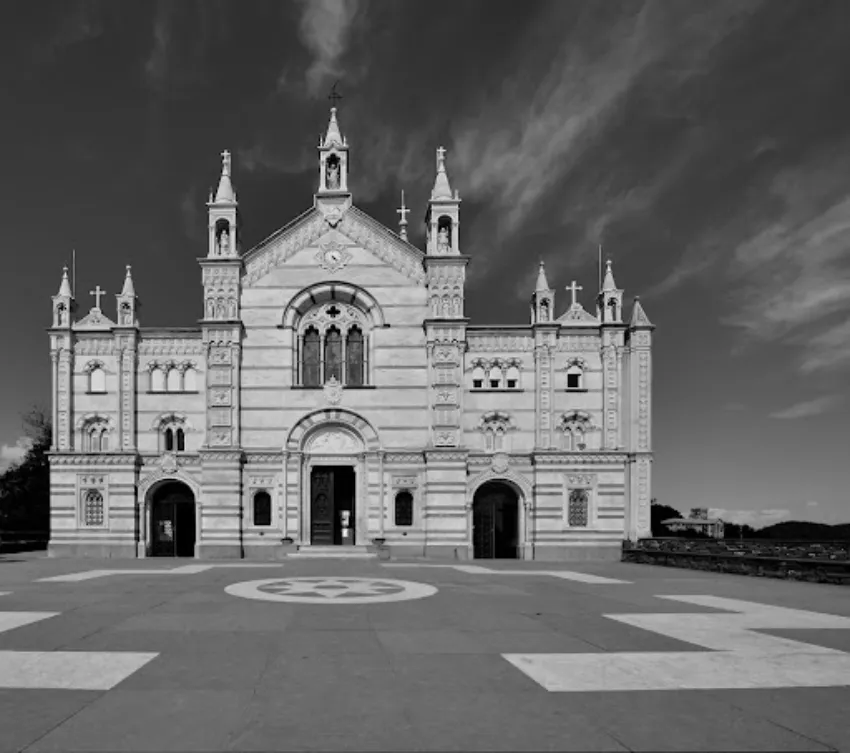
The people of Rapallo officially recognized Our Lady of Montallegro as their patroness in 1739, with strong support from the local clergy and the community. A formal decree from the archbishop of Genoa confirmed this honor. In 1767, the Byzantine icon was crowned as the “Queen” of Rapallo, and pilgrims received a plenary indulgence from Pope Clement XIII.
The sanctuary has welcomed numerous religious figures, including St. Francis de Sales, St. John Bosco, and Pope John XXIII. In 1942, the Vatican elevated the sanctuary to a minor basilica, further cementing its importance in the region.
Miracles and Devotion
Many miracles are attributed to the intercession of Our Lady of Montallegro, including the protection of Rapallo during epidemics. During the plague of 1657, the city was spared from the devastation that struck other parts of Liguria. The people of Rapallo made a vow to the Virgin, and every year, municipal authorities fulfill this vow by making a pilgrimage to the sanctuary.
Similarly, during the cholera outbreak of 1835, the city council pledged a new silver tablet to the Virgin, and when the epidemic ended, they donated it to the sanctuary.
In 1944, during World War II, Rapallo was protected from Allied bombings. A sudden gust of wind caused all bombs to miss their target, an event many locals attributed to the intervention of Our Lady of Montallegro.
Today, the sanctuary remains a place of pilgrimage and devotion, with a rich history of divine intervention and local reverence.
Architecture of Sanctuary of Our Lady of Montallegro, Italy
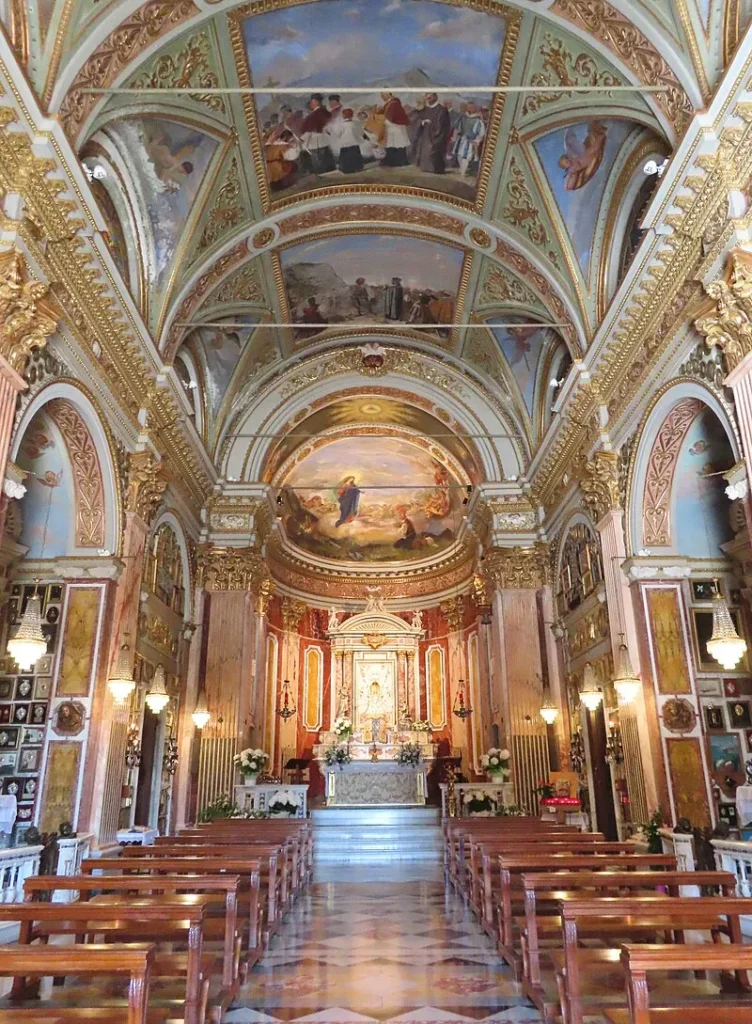
Architect: Luigi Rovelli
Architectural Style: Baroque Revival architecture
The Nave and Church Interior
The sanctuary, renovated and expanded primarily in 1640, features a single nave with four side altars. The high altar, where the revered small Byzantine painting is displayed for the faithful’s veneration, was specially placed in a Baroque silver pavilion in 1743, donated by the noble Tomaso Noce.
On the right side, the first altar houses the “Visitation” by Nicola Carlone (1704), while the second altar features a white marble crucifix by Francesco Schiaffino. On the left side, the second altar displays Luca Cambiaso’s “Annunciation,” and the first altar holds Nicolò Carlone’s “Our Lady of Sorrows” (1707).
Frescoes and decorative paintings on the vault and semi-dome were completed by Francesco Boero from Rapallo, depicting key historical and “miraculous” events related to the Byzantine icon. The scene of the Marian apparition to the peasant Giovanni Chichizola, above the high altar, was painted by Genoese artist Nicolò Barabino, while the altar itself is a 19th-century work by Luigi Rovelli.
The Organ and Bell Tower
The organ, crafted in 1907 by the Inzoli firm from Crema, adds to the sanctuary’s rich acoustics. The bell tower features eight bells, cast in 1946 by the renowned Capanni foundry in Castelnovo ne’ Monti (Re).
The Chapel of St. Joseph and the Penitentiary
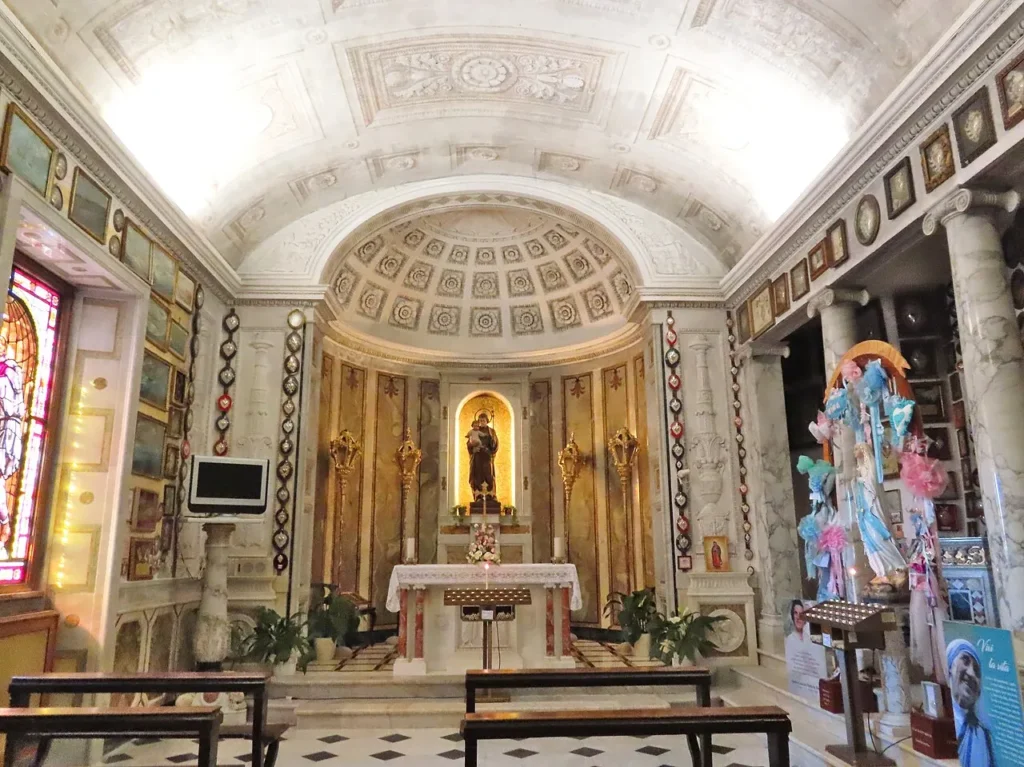
The Chapel of St. Joseph, located on the left side of the sanctuary, preserves the original spring of water that gushes from the rock. This sacred space was inaugurated with a solemn ceremony on March 19, 1966. Inside, visitors can find paintings, photographs, and votive offerings donated by people who claim to have been miraculously healed through the intercession of Our Lady of Montallegro.
The penitentiary, established in 1788, is located on the right wing of the sanctuary and is dedicated to St. Olcese Ursicino, and Saints Gervasius and Protasius. The walls of this room are adorned with votive offerings, tombstones, and inscriptions left by cardinals and other notable figures who have visited.
The Byzantine Painting
The small Byzantine painting housed in the sanctuary depicts the Virgin Mary’s transition to heaven. Painted on an 18×15 cm poplar wood tablet, the icon shows the Holy Trinity and the ascent of Mary’s soul to heaven at the moment of her death. Christian tradition holds that this icon has been kept at the sanctuary at the request of Our Lady herself.
Over the years, the icon has been linked to mysterious disappearances and reappearances. One notable incident occurred in 1574 when a ship from the Republic of Ragusa, led by Captain Nicola de Allegretis, was caught in a violent storm near the Cinque Terre. The captain prayed for salvation, vowing to visit the nearest sanctuary if they survived. The ship managed to reach the coast of Rapallo, where the entire crew safely disembarked and made their way to Montallegro to thank Our Lady. Upon arrival, they found the small Byzantine painting on the altar—an icon that, according to their testimonies, had disappeared years earlier from their church in Ragusa. This discovery led to accusations of theft against the people of Rapallo and a demand for the icon’s return. However, when the captain attempted to take the painting aboard his ship, it mysteriously disappeared again, only to reappear on the altar of Montallegro.
Since then, the painting has remained in the sanctuary, except for processions held during the patronal festival at the beginning of July. For the 450th anniversary of Our Lady’s apparition in 2007, the icon was taken on a historic journey to the parishes of the Chiavari diocese, which were part of the former captaincy of Rapallo.
In 1688, the image was reproduced in copper by the sculptor Antonio Floradi, making it available for prints. Over time, this venerated icon became a symbol of devotion, with many households in Rapallo and surrounding areas displaying representations of the image.
The Ex-Votos
Numerous ex-votos, both written testimonies and simple drawings, are displayed inside the sanctuary and surrounding spaces as expressions of gratitude for perceived miracles through the Virgin of Montallegro. The first ex-voto was donated in 1571 by Captain Agostino Canevale of Rapallo, who claimed to have been saved during the Battle of Lepanto. Unfortunately, this ex-voto was stolen during the Napoleonic occupation.
One of the most famous ex-votos is a silver plate donated by Captain Nicolò de Allegretis in 1574, known as the “Ex-Voto of the Ragusan.” After surviving a storm off the coast of Rapallo, the captain gave thanks to Our Lady, making a vow to honor her. This ex-voto is inscribed with the following message:
“December 26, 1574. Nicolò de Allegretis, the Ragusan, near Monterosso, made a vow to the Virgin Mary, Mother of God, and received the grace.”
The first ex-voto from the community of Rapallo was donated in 1657 to commemorate the city’s deliverance from the plague. This silver plate depicts a detailed view of Rapallo in the 18th century, from the Langano dock to the Da Vigo tower, offering an invaluable visual record of the town during that time. The inscription reads:
“In the name of the community of Rapallo, immune to the plague that raged everywhere, the most illustrious Captain Gio. Pietro Grimaldi dedicated this testimony with gratitude to the Mother of God of Montallegro in 1657.”
In 1747, the Republic of Genoa and the people of Rapallo donated another ex-voto to commemorate their survival of the Austro-Sardinian invasion during the War of the Austrian Succession. This embossed silver foil, crafted by Genoese engraver Luxardi, shows an 18th-century depiction of Rapallo, including the Monastery of the Poor Clares and the mouth of the San Francesco river.
The third ex-voto, donated by the civic administration in 1836, celebrates the city’s survival from a cholera outbreak. This silver foil, measuring 62 x 45 cm, features a panoramic view of Rapallo, as well as the new road to Santa Margherita Ligure built after the Boate stream was diverted.
Other ex-votos include a tribute from Queen Margherita of Savoy, donated on January 30, 1905, to commemorate the death of her husband, King Umberto I of Savoy, assassinated in Monza in 1900.
In an intriguing note, a three-meter-long stuffed crocodile hangs in the room where nuns sell religious items and books. It is said to be the strange tribute of a Rapallo commander who brought it back from the Amazon nearly three centuries ago.
The Silver Casket
The ceremonial silver casket, displayed for veneration at the Basilica of Saints Gervasius and Protasius, was first commissioned in 1698 by the administrators of the basilica. Created by a Genoese goldsmith, the casket was a meticulous reproduction of the small Byzantine painting, placed on a pedestal and surrounded by depictions of Our Lady of the Rosary, Saints Gervasius and Protasius, St. Blaise, and St. Erasmus. The piece required over 350 ounces of silver and cost a total of 1,750 Genoese liras to produce.
On March 22, 1779, the casket was further adorned with the addition of the Virgin’s icon, surrounded by angels holding a crown above a reproduction of the miraculous cliff. In 1782, the municipal coat of arms of Rapallo, also in silver, was affixed to the ark.
During the Austrian occupation of Rapallo in 1799, the silver casket was seized by the occupying forces, with intentions to melt it down for the Austrian Empire’s benefit. However, the people of Rapallo successfully redeemed the casket for a sum of 4,126 liras, though the municipal coat of arms was removed due to an Austrian decree.
The casket underwent further restoration in 1838, during which new silver elements were added while carefully preserving the original parts. The restoration cost 20,097 Piedmontese liras, but the amount was easily raised thanks to contributions from the six districts of the city.
In 1844, a golden crown, donated by the Rapallo lacemakers, was placed on the Virgin’s image. The crown, valued at 1,400 Piedmontese liras, remains a cherished part of the casket.
The "July Festivals"
The “July Festivals,” celebrated in Rapallo in honor of the patron saint, take place over three days—July 1st, 2nd, and 3rd. During these festivities, the six city districts—Borzoli, Cappelletta, Cerisola, Costaguta, Seglio, and San Michele—hold nightly fireworks displays. Each year, one district is chosen to honor the Madonna, with special emphasis on the famous “Panegyric of midday.”
On the morning of July 1st, at exactly 8 AM, the districts begin the celebration with the “messa in cassa,” when the gold and silver statue of Our Lady of Montallegro is placed in its silver ark and exposed for veneration inside the Basilica of Saints Gervasio and Protasio. The Sestiere of San Michele starts the festivities with the first firecracker, known as “ou l’è au Langan” (from the Langano pier), followed by the other districts—Seglio-San Rocco, Borzoli, Cerisola, Cappelletta, and Costaguta—each offering their “recall” fireworks in a rhythmic pattern reminiscent of a popular Rosary.
Over the course of the celebrations, two of the districts are chosen (on rotation, due to safety regulations) to put on a daytime fireworks display from barges in the center of the water in front of the seafront promenade. These daytime fireworks are characterized by loud, thunderous shots.
In the evening, after the district fireworks, the waters of Rapallo are illuminated by vibrant displays. During the wait for the fireworks, small cylindrical candles, known as “lumetti rapallini,” are placed in the sea by participants.
On the anniversary of the apparition, July 2nd, the district responsible for the Panegyric organizes a grand celebration. Firecrackers are positioned along the pedestrian area of the Vittorio Veneto seafront, and a massive eruption of sound, referred to as “u ramadan,” accompanies the grand finale.
The final day, July 3rd, features a procession through the city center and along the seafront, with bearers carrying images of Christ and the silver ark containing Our Lady of Montallegro. One of the most visually striking moments occurs with the symbolic “burning” of the castle on the sea, where red smoke bombs create a dramatic cascade of light over the water.
Before the castle burning, a traditional firecracker explosion known as the “Sparata dei Ragazzi” takes place. Historically, this event was handled by the younger generation, but due to safety regulations, only adults with special licenses can now participate.
Feast Day
Feast Day : 2nd July
The feast day of Our Lady of Montallegro is celebrated on July 2nd each year. This date commemorates the apparition of the Virgin Mary to a peasant named Giovanni Chichizola in 1557, near the hill of Montallegro in the Italian region of Liguria. The sanctuary, which was built in her honor, hosts various religious ceremonies and processions, especially during this time.
Church Mass Timing
Monday : 10:30 am, 4:00 pm and 5:00 pm
Tuesday : 10:30 am, 4:00 pm and 5:00 pm
Wednesday : 10:30 am, 4:00 pm and 5:00 pm
Thursday : 10:30 am, 4:00 pm and 5:00 pm
Friday : 10:30 am, 4:00 pm and 5:00 pm
Saturday : 9:00 am, 10:30 am, 4:00 pm and 5:00 pm
Sunday : 8:00 am, 10:00 am, 11:30 am, 4:00 pm and 5:00 pm
Church Opening Time:
Monday : 8:00 am – 6:00 pm
Tuesday : 8:00 am – 6:00 pm
Wednesday : 8:00 am – 6:00 pm
Thursday : 8:00 am – 6:00 pm
Friday : 8:00 am – 6:00 pm
Saturday : 8:00 am – 6:00 pm
Sunday : 7:30 am – 6:30 pm
Contact Info
Address :
Sanctuary of Our Lady of Montallegro, Italy
Via al Santuario, 24, 16035 Rapallo GE,
Italy.
Phone : +390185239000
Accommodations
Connectivities
Airway
Genoa Cristoforo Colombo Airport (GOA)to Sanctuary of Our lady of Montallegro Italy distance between 55 min (47.7 km) via A12/E80.
Railway
Rapallo Station to Sanctuary of Our lady of Montallegro Italy distance between 21 min (10.2 km) via SP58 and Via S. Maurizio di Monti.

